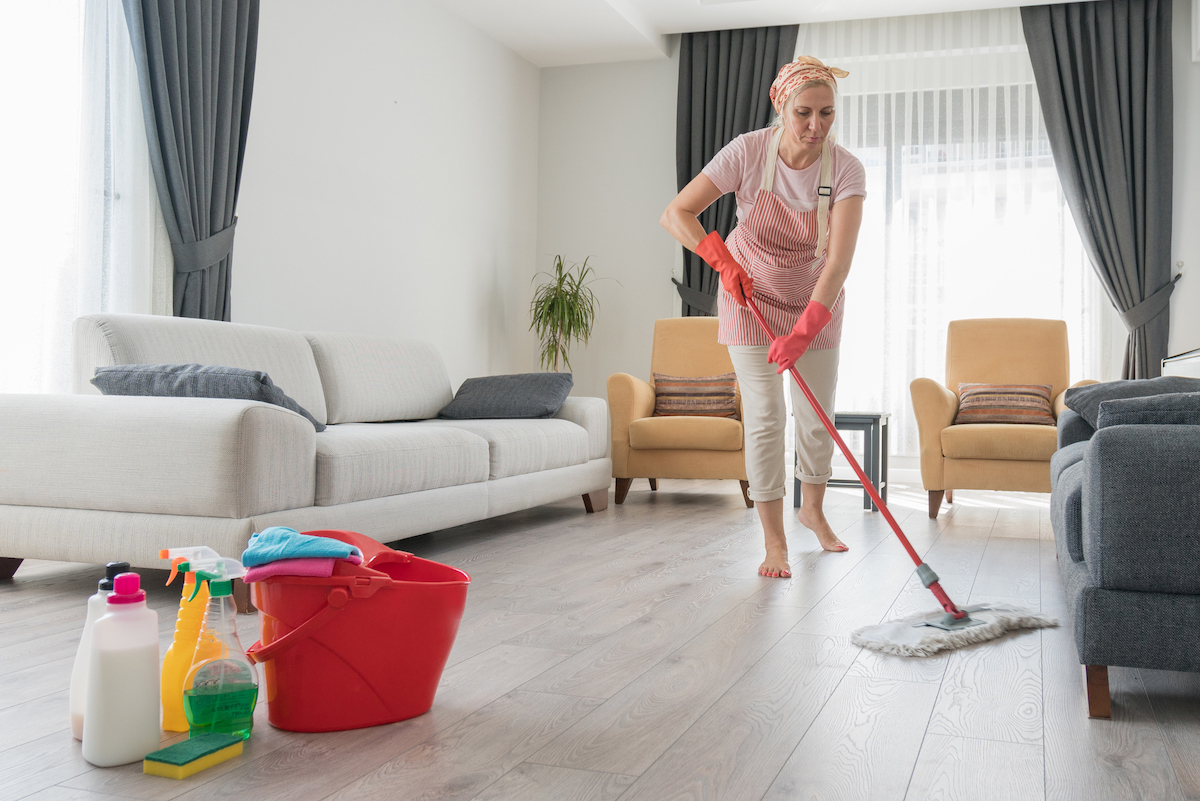

We may earn revenue from the products available on this page and participate in affiliate programs. Learn More ›
Vinyl plank flooring is a popular alternative to hardwood flooring, especially in areas of the home that are exposed to moisture. Vinyl plank flooring can last a long time and can hold up to moisture better than hardwood, but it still requires a bit of love and care.
“Always follow the specific manufacturer’s instructions for cleaning,” says Paul Carter, EVP, Strategic Initiatives at Empire Today. This guide will teach you how to clean vinyl floors easily and regularly to maintain their condition, how to prevent damage to vinyl floors, and which tools or cleaning products to avoid when cleaning this type of flooring.
Tools & Materials
Bobvila.com may earn a commission from purchases made through these links.
- Dust mop, flat mop, or dry mop
- Vacuum
- Mop or microfiber flat mop
- Soft cloth (white)
- Soft nylon-bristle brush
What Are Vinyl Plank Floors?
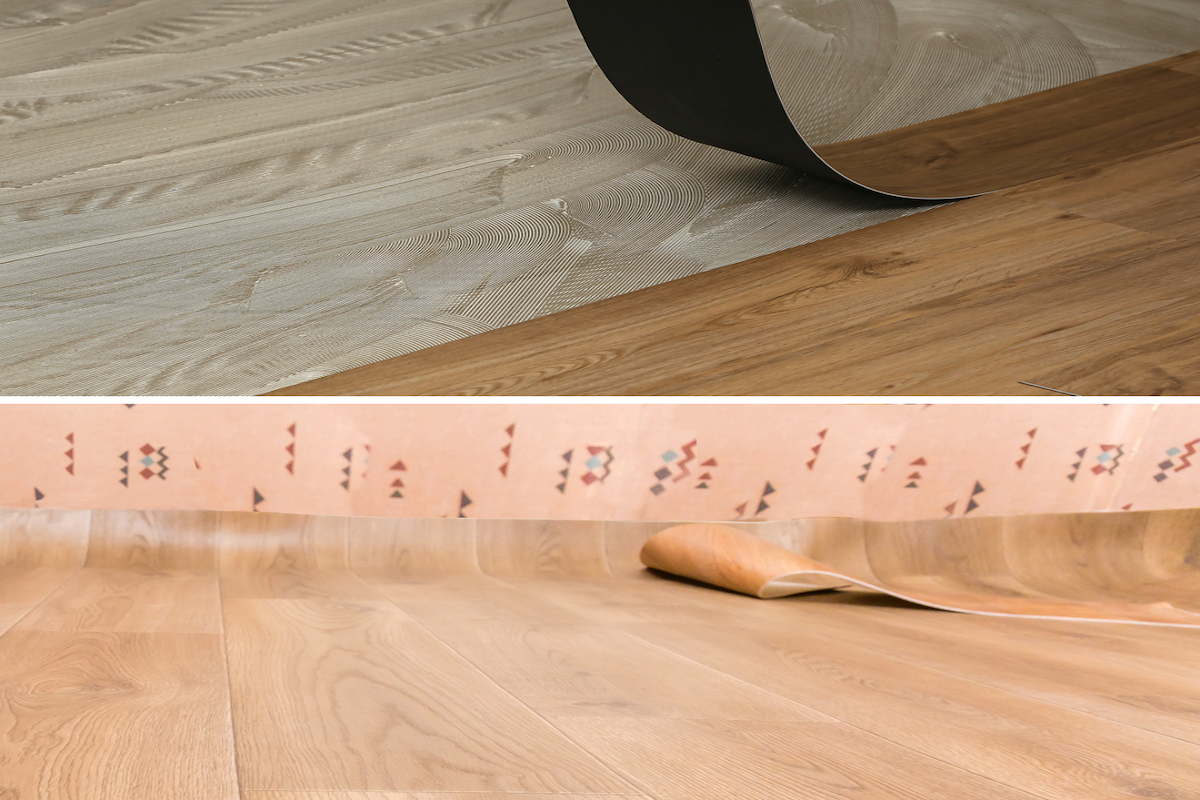
Basic vinyl plank flooring is made of the same materials (PVC) and layers as vinyl sheet flooring but is sold in planks and is usually designed to look like hardwood or tile. Both types of vinyl flooring consist of a base layer, decorated layer, and wear layer. The PVC and added compounds that help improve its durability are highly water-resistant or even waterproof and help make it less likely that water and stains will penetrate the vinyl.
Vinyl plank floors typically have five layers, including a top coat and a backing layer. Both plank and sheet vinyl options are highly durable and easy to clean, a plus for high-traffic areas of a home. But vinyl planks are easier to install, and some require no adhesive. The wear layer of vinyl flooring is transparent, so it can be damaged if cleaned with abrasive tools or the wrong cleaners.
How to Clean Vinyl Floors
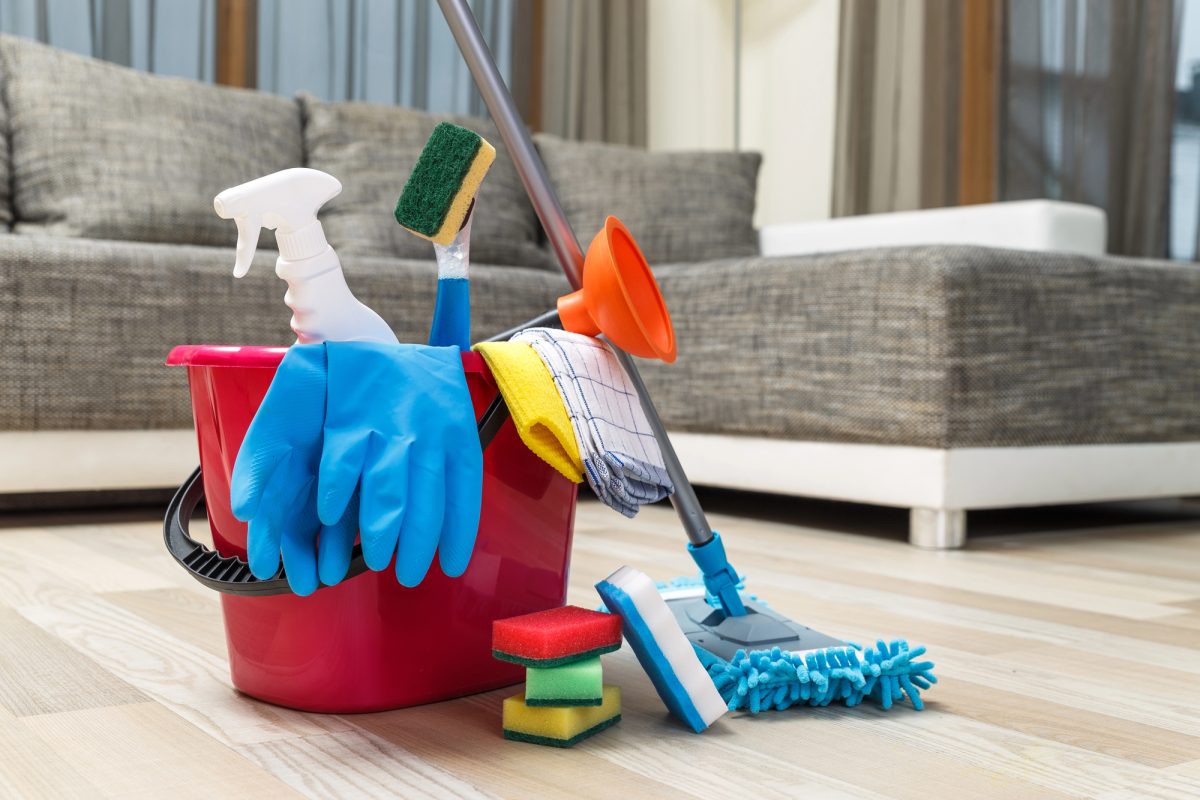
Cleaning vinyl flooring is a pretty straightforward and inexpensive task. Wet mopping can effectively clean vinyl sheet flooring, but is best avoided on vinyl plank floors. “I generally recommend people refrain from ‘wet’ mopping vinyl plank flooring as there is potential for water to seep around the perimeter of the install and get under the flooring,” Carter says. “Sheet vinyl flooring is usually at least perimeter-glued, which prevents this.” Even when mopping sheet vinyl, the key is not to soak the mop. Use just enough water to get the job done.
Sweep Regularly
The best strategy for maintaining vinyl floors is to use a flat dust mop, dry mop, or other flat mop as often as you can—daily, if that’s feasible.
Why the frequent dust mopping? Dirt and debris can build up or get walked on, which increases the likelihood that it will dull or scratch the floor’s vinyl surface. Work a flat mop along baseboards, in corners, and under furniture; sweep up and dispose of debris with a dustpan.

Carpet, hardwood, vinyl, and tile flooring.
Bob Vila has partnered with Empire Today to help you easily get beautiful new floors at a great price. Free In-Home EstimatesSweep and Vacuum Right Before Mopping
Always dry mop and vacuum the floor to remove surface dirt, dust, and hair before wet mopping it. After a thorough pass with a dust mop, run the vacuum—with the rotating brush or beater bar off—over the surface. (Rotating brushes and other vacuum attachments can damage vinyl floors.) Be sure to vacuum over any gaps between planks to remove dirt and debris the mop might have missed.
Mop With Vinyl-Safe Solutions
For regular cleaning, a damp mop and warm water can help keep vinyl flooring looking its best. Always wring out the mop or flat mop pad to avoid drenching the vinyl with water. Do this easy mopping whenever you feel the floor needs a touch-up. Do not use a wet (string or sponge) mop on vinyl planks; opt for a flat mop.
Every few months, deep-clean vinyl floors with a cleaner labeled as safe for vinyl floors or recommended by the flooring manufacturer. Typically, these products are pH neutral and contain no abrasive cleaners, ammonia, or bleach. Be sure to follow the floor manufacturer’s instructions and any cautions on the cleaning product label.
Although you can clean your floors with vinegar and water, do so only after checking care instructions from the floor manufacturer, since vinegar is acidic. Never apply vinegar directly to vinyl floor planks, and immediately wipe up spills of acidic liquids like vinegar or lemon juice. For cleaning, dilute the vinegar in hot water—1 cup of vinegar for each gallon of water.
If the floors are especially dirty, mop them first with a mixture of hot water and a few drops of liquid dish soap, followed by a pass of plain warm water or vinegar diluted in water to remove soap residue. As an alternative, try a commercial vinyl floor cleaner to erase built-up or widespread dirt.
Clean Spills and Stains as They Occur
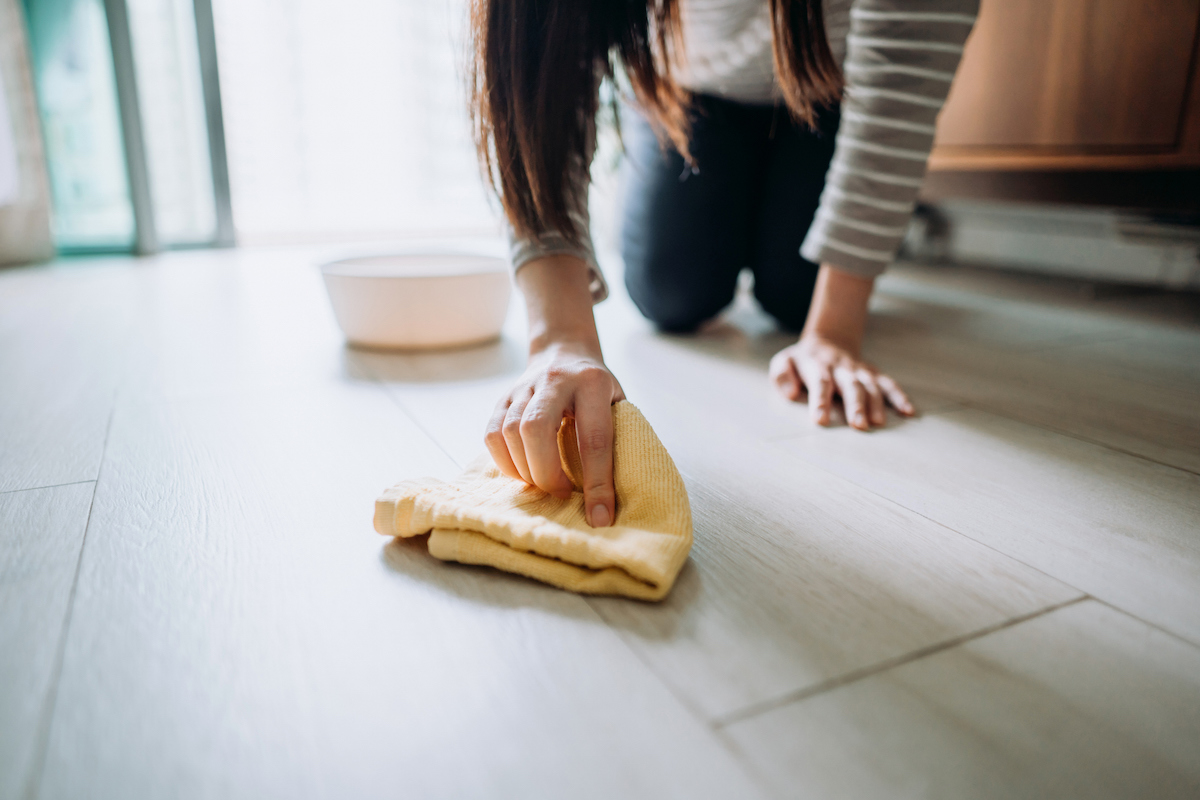
Attending to spills promptly is an important step in learning how to clean vinyl plank floors. Use a soft cloth dipped in warm water to wipe up spills as soon as they occur. Regular sweeping and mopping with warm water, too, can prevent stains from setting in. If, despite your best efforts, stains develop on your vinyl flooring, here’s what you might try to remove them:
- Make a paste of baking soda and water, and gently rub the stain with a soft cloth or sponge until the mark disappears. Repeat this process if necessary. Wipe the area thoroughly with a soft damp cloth or rag (white only, not one that’s dyed) to remove any traces of baking soda.
- Liquid dish soap or laundry detergent can also work on stains, but test the detergent or any household solvents in an inconspicuous corner or inside a closet to be sure the product does not damage the flooring’s wear layer.
- Although a soft, clean cloth is best for spot cleaning vinyl floors, a nylon-bristle brush, used with common household solvents, can help remove many types of stains.
- Certain solvents can remove some stains better than others. Rubbing alcohol, for instance, can lift lipstick, hair dye, and ink stains. Mineral spirits work on crayon, paint, and marker stains.
- Use an acetone-based nail polish remover to lift nail polish or other stubborn stains.

Carpet, hardwood, vinyl, and tile flooring.
Bob Vila has partnered with Empire Today to help you easily get beautiful new floors at a great price. Free In-Home EstimatesAttend to Scratches and Scuffs
Shoes, furniture, and dropped items can all scratch or scuff the surface of vinyl flooring, which is why preventing scratches and scuffs in the first place should be top of mind for homeowners and renters. Using WD-40, olive oil, pencil erasers and sandpaper have all been touted as scratch-and-scuff remedies, but Carter does not recommend them. Instead, the Empire Today EVP recommends replacing the vinyl planks altogether. With vinyl plank flooring, the good news is that you can replace a single plank instead of an entire floor, which gives plank vinyl an advantage over sheet vinyl.
How to Prevent Damage to Vinyl Flooring
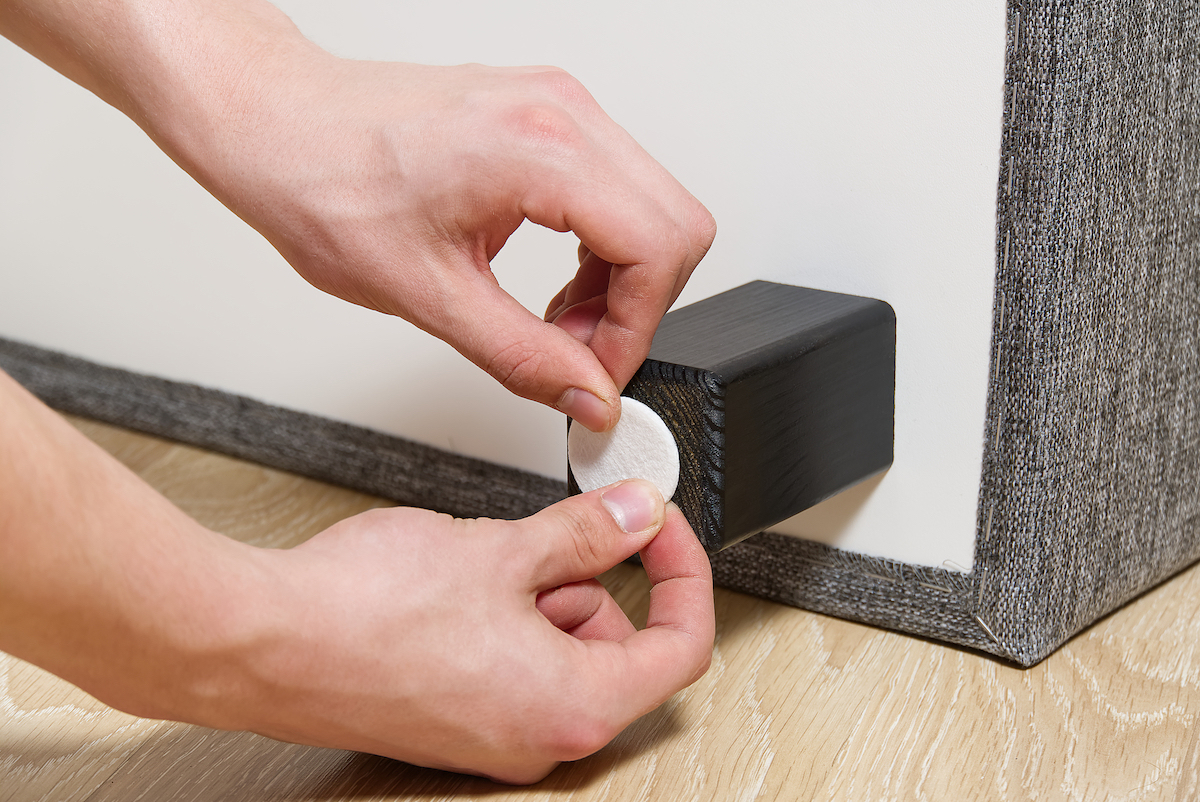
The best way to keep a vinyl floor clean is to minimize dirt, stains, and abrasions. Over time, dirt and dust can wear down and degrade the finish on any type of flooring, including vinyl planks. These tips will help prevent damage to vinyl plank flooring:
- Clean up spills immediately.
- Place a good-quality doormat or area rug at doorways so grit and grime don’t migrate into the house.
- Avoid rubber-backed doormats, which can stain vinyl.
- If possible, avoid wearing outdoor shoes on vinyl flooring. Small pebbles or other items stuck in soles can scuff the floor.
- Put a sheet of paneling, heavy cardboard, a bedsheet, or a mat under furniture whenever it’s being moved to prevent marks or tears.
- Place vinyl coasters under the feet and legs of your furniture to safeguard against permanent indentations, or line the bottom of furniture legs with felt furniture padding.
The Dos and Don’ts of Cleaning Vinyl Flooring

Vinyl floor care is pretty simple, but there are a few missteps to avoid when cleaning vinyl flooring:
- Don’t use wax polishes on vinyl flooring; they leave a film that builds up.
- Do purchase floor cleaners designed specifically for vinyl flooring.
- Avoid products with strong-colored dyes, such as purples, blues, and orange. “These can cause discoloration of the wear layers on vinyl flooring,” says Empire Today’s Carter.
- Do use soft rags or mops; abrasive tools like steel wool can damage vinyl flooring.
- Do remember that vinyl plank floors have small but numerous gaps that require extra attention when vacuuming or cleaning.
- Don’t use abrasive cleaners, bleach, or ammonia, which can damage the protective wear layer on top of the vinyl.
- Do test household or commercial products in an out-of-the-way spot on the floor to make sure they cause no damage.
